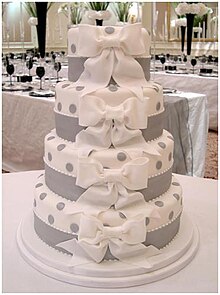Wedding cake: Difference between revisions
m robot Adding: ca:Pastís de noces |
→See also: added anothe cake found at weddings |
||
| Line 15: | Line 15: | ||
{{commons+cat|Wedding cake|Wedding cakes}} |
{{commons+cat|Wedding cake|Wedding cakes}} |
||
*[[Croquembouche]] - A French wedding cake tradition |
*[[Croquembouche]] - A French wedding cake tradition |
||
*[[Groom's cake]] |
|||
*[[Kransekake]] - A Scandinavian wedding cake tradition |
*[[Kransekake]] - A Scandinavian wedding cake tradition |
||
*[[Stack cake]] |
*[[Stack cake]] |
||
Revision as of 19:48, 25 November 2009
This article needs additional citations for verification. (March 2008) |

A wedding cake is the traditional cake served to the guests at a wedding reception (or in parts of England, at a wedding breakfast) after a wedding. In modern Western culture, it is usually a large cake, multi-layered or tiered, and heavily decorated with icing, occasionally over a layer of marzipan or fondant, topped with a small statue representing the couple. Achieving a dense, strong cake that can support the decorations while remaining edible can be considered the epitome of the baker's art and skill. The average cost of a wedding cake in the U.S. in 2005 was $543.[1]
Modern adaptations

Wedding cake toppers are small models that sit on top of the cake, normally a representation of a bride and groom in formal wedding attire. This custom was dominant in US wedding in the 1950s where it represented togetherness.[2] Modern weddings have embraced more variety in design and significance. Wedding toppers today are often figures that indicate shared hobbies or other passions.[2]
See also
- Croquembouche - A French wedding cake tradition
- Groom's cake
- Kransekake - A Scandinavian wedding cake tradition
- Stack cake
- White wedding
- Wedding dress
- Icingtons
References
- ^ The Wedding Report, market research from the Bridal Association of America, 2005. Retrieved August 16 2007.
- ^ a b Cele Otones and Elizabeth Pleck (2003), Cinderella Dreams: The Allure of the Lavish Wedding, University of California Press, p. 124-125, ISBN 0-520-24008-1
